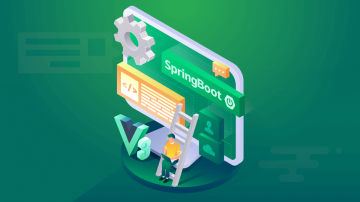Spring Boot框架学习涵盖了从快速搭建项目到开发RESTful API、集成数据库和使用模板引擎等多个方面,详细介绍如何使用Spring Boot进行Web应用开发。文章还提供了详细的开发环境搭建指南,包括Java环境配置和IDE设置,帮助读者快速入门Spring Boot框架。
Spring Boot简介Spring Boot是什么
Spring Boot 是一个用来简化新Spring应用初始搭建以及开发过程的框架,通过约定优于配置的方式,减少开发人员对Spring框架本身API的繁琐配置。Spring Boot可以帮助开发者快速搭建项目,并通过自动配置的方式使开发者能够专注于业务逻辑的实现。
Spring Boot的优势
- 快速启动项目:通过约定优于配置的方式,开发人员可以快速启动一个Spring项目,无需过多配置。
- 自动配置:能够自动配置应用所需的资源,如数据库连接、缓存、邮件服务等,减少开发人员的工作量。
- 无依赖冲突:依赖管理通过Maven或Gradle来完成,避免不同版本之间的冲突。
- 独立运行:Spring Boot应用可以独立运行,内置了Tomcat、Jetty等Web服务器,使得应用不需要部署到外部的Web服务器上。
- 易于测试:易于单元测试和集成测试,支持多种测试框架。
Spring Boot的应用场景
Spring Boot适用于需要快速开发和部署的项目,特别是以下场景:
- Web应用:开发Web应用时,Spring Boot可以快速集成多种Web框架,如Spring MVC、Spring WebFlux等。
- 微服务开发:在微服务开发中,Spring Boot可以和其他微服务框架(如Spring Cloud、Netflix OSS等)无缝集成。
- 数据处理:处理大量数据时,Spring Boot可以集成多种数据库和缓存技术,如JPA、MyBatis、Redis等。
- API开发:开发RESTful API时,Spring Boot提供了丰富的功能支持,如Spring Data REST、Spring WebFlux。
下载并安装Java开发环境
- 访问JDK官方网站(https://www.oracle.com/java/technologies/javase-jdk11-downloads.html)下载适合的操作系统版本的JDK。
- 安装JDK时,请确保安装路径中没有特殊字符或空格,安装完成后,配置环境变量
JAVA_HOME和PATH。 - 检查Java安装是否成功,可以在命令行中输入
java -version来查看安装的Java版本。
配置IDE(如IntelliJ IDEA、Eclipse)
IntelliJ IDEA
- 下载并安装IntelliJ IDEA社区版(https://www.jetbrains.com/idea/download/)。
- 打开IntelliJ IDEA,选择
File->New->Project创建一个新的项目。 - 选择
Spring Initializr,选择对应的Java版本和Spring Boot版本,填写项目名称和包名,点击Next->Finish完成项目创建。
Eclipse
- 下载并安装Eclipse(https://www.eclipse.org/downloads/)。
- 安装完成后,打开Eclipse,通过
Help->Eclipse Marketplace安装Spring Tools 4插件。 - 安装完成后,重启Eclipse,选择
File->New->Spring Starter Project创建一个新的项目。
下载并配置Spring Boot开发工具
Maven
- 访问Maven官方网站(https://maven.apache.org/)下载Maven。
- 解压下载的文件,配置环境变量
MAVEN_HOME和PATH,确保命令行中可以运行mvn命令。 - 在IDE中配置Maven,将Maven的
bin目录添加到IDE的构建路径中。
Gradle
- 访问Gradle官方网站(https://gradle.org/)下载Gradle。
- 解压下载的文件,配置环境变量
GRADLE_HOME和PATH,确保命令行中可以运行gradle命令。 - 在IDE中配置Gradle,将Gradle的
bin目录添加到IDE的构建路径中。
使用Spring Boot CLI
- 访问Spring Boot CLI官方网站(https://spring.io/tools/cli)下载适合的操作系统版本的Spring Boot CLI。
- 解压下载的文件,配置环境变量
SPRING_BOOT_CLI_HOME和PATH,确保命令行中可以运行spring命令。
创建Spring Boot项目
使用Spring Initializr快速创建一个Spring Boot项目。
- 访问Spring Initializr网站(https://start.spring.io/)。
- 选择项目类型为
Maven Project,语言为Java,依赖为Spring Web。 - 填写项目名称为
hello-spring-boot,包名com.example,其他默认配置。 - 点击
Generate下载项目压缩包。 - 解压压缩包,导入到IDE中,如果是Eclipse,直接解压文件夹,如果是IntelliJ IDEA,使用
File->New->Project from Existing Sources导入。
# 命令行创建项目示例
spring init --dependencies=web,thymeleaf --groupId=com.example --artifactId=hello-spring-boot --version=0.0.1-SNAPSHOT项目结构介绍
Spring Boot项目的基本结构如下:
hello-spring-boot
│ .gitignore
│ pom.xml
│ src\
│ │ main\
│ │ │ java\
│ │ │ │ com\
│ │ │ │ │ example\
│ │ │ │ │ │ HelloSpringBootApplication.java
│ │ │ │ │ │ HelloController.java
│ │ │ │ │ │
│ │ │ │ │ application.properties
│ │ │ │ │ application.yml
│ │ │ │ │
│ │ │ │ resources\
│ │ │ │ │ static\
│ │ │ │ │ templates\
│ │ │ │ │ application.yml
│ │ │ │ │
│ │ │ │ META-INF\
│ │ │ │ │ spring.factories
│ │ │ │
│ │ │ test\
│ │ │ │ java\
│ │ │ │ │ com\
│ │ │ │ │ │ example\
│ │ │ │ │ │ HelloSpringBootApplicationTests.javasrc/main/java/com/example/HelloSpringBootApplication.java:主入口类,使用@SpringBootApplication注解,启动整个Spring Boot应用。src/main/java/com/example/HelloController.java:控制器类,处理HTTP请求。src/main/resources/application.properties或application.yml:配置文件。src/main/resources/static:静态资源文件,如JS、CSS、图片等。src/main/resources/templates:模板文件,如Thymeleaf模板。src/test/java/com/example/HelloSpringBootApplicationTests.java:单元测试文件。
运行第一个Spring Boot项目
- 在IDE中运行项目,如果使用IntelliJ IDEA,直接右键
HelloSpringBootApplication.java,选择Run。 - 项目运行后,打开浏览器,访问
http://localhost:8080/hello,可以看到项目返回的响应信息。
在HelloController.java中添加以下代码:
package com.example;
import org.springframework.web.bind.annotation.GetMapping;
import org.springframework.web.bind.annotation.RestController;
@RestController
public class HelloController {
@GetMapping("/hello")
public String hello() {
return "Hello Spring Boot!";
}
}在HelloSpringBootApplication.java中添加以下代码:
package com.example;
import org.springframework.boot.SpringApplication;
import org.springframework.boot.autoconfigure.SpringBootApplication;
@SpringBootApplication
public class HelloSpringBootApplication {
public static void main(String[] args) {
SpringApplication.run(HelloSpringBootApplication.class, args);
}
}打开浏览器,访问http://localhost:8080/hello,可以看到返回的字符串Hello Spring Boot!。
配置文件介绍(application.properties/application.yml)
Spring Boot支持两种配置文件格式:application.properties和application.yml。这两种文件用于定义应用程序的配置,如数据库连接、服务器端口等。
application.properties
spring.datasource.url=jdbc:mysql://localhost:3306/dbname
spring.datasource.username=root
spring.datasource.password=root
spring.datasource.driver-class-name=com.mysql.jdbc.Driver
server.port=8080
server.tomcat.allow-upgrade=falseapplication.yml
spring:
datasource:
url: jdbc:mysql://localhost:3306/dbname
username: root
password: root
driver-class-name: com.mysql.jdbc.Driver
server:
port: 8080
tomcat:
allow-upgrade: false常用配置项讲解
-
Spring Boot应用配置项
spring.application.name:指定应用名称。spring.profiles.active:指定活动的配置文件。spring.main.banner-mode:控制启动时显示的Banner。
-
Web服务器配置项
server.port:指定应用启动的端口号。server.tomcat.max-threads:指定Tomcat的最大线程数。server.tomcat.uri-encoding:设置Tomcat的URI编码。
- 数据源配置项
spring.datasource.url:数据源的JDBC URL。spring.datasource.username:数据库用户名。spring.datasource.password:数据库密码。spring.datasource.driver-class-name:数据库驱动类名。
自动配置原理简介
Spring Boot的自动配置机制通过@SpringBootApplication注解中的@EnableAutoConfiguration启用。@EnableAutoConfiguration会扫描类路径下的配置文件,根据配置文件中的信息查找匹配的配置类,从而完成自动配置。Spring Boot通过SpringFactoriesLoader加载spring.factories文件中的配置类,这些配置类会根据特定的配置项自动配置Spring容器中的Bean。
RESTful API的创建与测试
使用Spring Boot可以很容易地创建RESTful API。下面是一个简单的示例,创建一个RESTful API用于查询用户信息。
- 创建一个新的控制器类
UserController.java,用于处理HTTP请求。
package com.example;
import org.springframework.web.bind.annotation.GetMapping;
import org.springframework.web.bind.annotation.RequestMapping;
import org.springframework.web.bind.annotation.RestController;
import java.util.Arrays;
import java.util.List;
@RestController
@RequestMapping("/users")
public class UserController {
private List<User> users = Arrays.asList(
new User(1, "张三", "zhangsan@example.com"),
new User(2, "李四", "lisi@example.com")
);
@GetMapping
public List<User> getUsers() {
return users;
}
}
class User {
private int id;
private String name;
private String email;
public User(int id, String name, String email) {
this.id = id;
this.name = name;
this.email = email;
}
public int getId() {
return id;
}
public String getName() {
return name;
}
public String getEmail() {
return email;
}
}- 在
HelloSpringBootApplication.java中添加UserController类的扫描路径。
package com.example;
import org.springframework.boot.SpringApplication;
import org.springframework.boot.autoconfigure.SpringBootApplication;
@SpringBootApplication
public class HelloSpringBootApplication {
public static void main(String[] args) {
SpringApplication.run(HelloSpringBootApplication.class, args);
}
}- 运行项目,访问
http://localhost:8080/users,可以看到返回的用户列表。
数据库集成(如使用JPA和Spring Data JPA)
使用Spring Data JPA可以快速实现数据库的持久化操作,下面通过一个简单的示例演示如何使用JPA和Spring Data JPA。
- 在
pom.xml或build.gradle中添加JPA和MySQL的依赖。
pom.xml
<dependencies>
<dependency>
<groupId>org.springframework.boot</groupId>
<artifactId>spring-boot-starter-web</artifactId>
</dependency>
<dependency>
<groupId>org.springframework.boot</groupId>
<artifactId>spring-boot-starter-data-jpa</artifactId>
</dependency>
<dependency>
<groupId>mysql</groupId>
<artifactId>mysql-connector-java</artifactId>
</dependency>
</dependencies>build.gradle
dependencies {
implementation 'org.springframework.boot:spring-boot-starter-web'
implementation 'org.springframework.boot:spring-boot-starter-data-jpa'
implementation 'mysql:mysql-connector-java'
}- 配置数据库连接信息。
application.properties
spring.datasource.url=jdbc:mysql://localhost:3306/dbname
spring.datasource.username=root
spring.datasource.password=root
spring.datasource.driver-class-name=com.mysql.jdbc.Driver
spring.jpa.hibernate.ddl-auto=update- 创建一个实体类
User.java,使用@Entity注解标记为实体类。
package com.example;
import javax.persistence.Entity;
import javax.persistence.GeneratedValue;
import javax.persistence.GenerationType;
import javax.persistence.Id;
@Entity
public class User {
@Id
@GeneratedValue(strategy = GenerationType.IDENTITY)
private Long id;
private String name;
private String email;
public Long getId() {
return id;
}
public void setId(Long id) {
this.id = id;
}
public String getName() {
return name;
}
public void setName(String name) {
this.name = name;
}
public String getEmail() {
return email;
}
public void setEmail(String email) {
this.email = email;
}
}- 创建一个持久化层接口
UserService.java,使用@Repository注解标记为数据访问层。
package com.example;
import org.springframework.data.jpa.repository.JpaRepository;
public interface UserService extends JpaRepository<User, Long> {
}- 创建一个控制器
UserController.java,使用UserService接口进行数据操作。
package com.example;
import org.springframework.beans.factory.annotation.Autowired;
import org.springframework.web.bind.annotation.GetMapping;
import org.springframework.web.bind.annotation.RequestMapping;
import org.springframework.web.bind.annotation.RestController;
import java.util.List;
@RestController
@RequestMapping("/users")
public class UserController {
@Autowired
private UserService userService;
@GetMapping
public List<User> getUsers() {
return userService.findAll();
}
}- 运行项目,访问
http://localhost:8080/users,可以看到返回的用户列表。
Thymeleaf模板引擎的使用
Thymeleaf是一个Java服务器端模板引擎,可以用于生成HTML、XML、JavaScript等静态文件。下面通过一个简单的示例演示如何使用Thymeleaf。
- 在
pom.xml或build.gradle中添加Thymeleaf的依赖。
pom.xml
<dependency>
<groupId>org.springframework.boot</groupId>
<artifactId>spring-boot-starter-thymeleaf</artifactId>
</dependency>build.gradle
implementation 'org.springframework.boot:spring-boot-starter-thymeleaf'- 在
src/main/resources/templates目录下创建一个HTML模板文件index.html。
<!DOCTYPE html>
<html xmlns:th="http://www.thymeleaf.org">
<head>
<title>Thymeleaf Example</title>
</head>
<body>
<h1 th:text="'Hello, ' + ${name}">Hello, World</h1>
</body>
</html>- 创建一个控制器
HomeController.java,将模板文件渲染为HTML响应。
package com.example;
import org.springframework.stereotype.Controller;
import org.springframework.ui.Model;
import org.springframework.web.bind.annotation.GetMapping;
@Controller
public class HomeController {
@GetMapping("/")
public String home(Model model) {
model.addAttribute("name", "Spring Boot Thymeleaf");
return "index";
}
}- 运行项目,访问
http://localhost:8080/,可以看到渲染的HTML页面。
单元测试与集成测试
Spring Boot支持使用JUnit 5、Mockito等工具进行单元测试和集成测试。
- 添加测试依赖。
pom.xml
<dependencies>
<dependency>
<groupId>org.springframework.boot</groupId>
<artifactId>spring-boot-starter-test</artifactId>
<scope>test</scope>
</dependency>
</dependencies>build.gradle
dependencies {
testImplementation 'org.springframework.boot:spring-boot-starter-test'
}- 创建一个单元测试类
UserControllerTests.java。
package com.example;
import org.junit.jupiter.api.Test;
import org.springframework.beans.factory.annotation.Autowired;
import org.springframework.boot.test.autoconfigure.web.servlet.WebMvcTest;
import org.springframework.test.web.servlet.MockMvc;
import static org.springframework.test.web.servlet.request.MockMvcRequestBuilders.get;
import static org.springframework.test.web.servlet.result.MockMvcResultMatchers.status;
import static org.springframework.test.web.servlet.result.MockMvcResultMatchers.content;
@WebMvcTest(UserController.class)
public class UserControllerTests {
@Autowired
private MockMvc mockMvc;
@Test
public void shouldReturnDefaultMessage() throws Exception {
mockMvc.perform(get("/users"))
.andExpect(status().isOk())
.andExpect(content().string("[" +
"{" +
"\"id\":1," +
"\"name\":\"张三\"," +
"\"email\":\"zhangsan@example.com\"" +
"}," +
"{" +
"\"id\":2," +
"\"name\":\"李四\"," +
"\"email\":\"lisi@example.com\"" +
"}" +
"]"));
}
}- 运行测试类,确保所有测试用例通过。
应用打包与发布
使用Maven或Gradle可以将应用打包成一个可执行的JAR文件,然后可以通过命令行运行。
Maven
mvn clean packageGradle
./gradlew clean bootJar执行上述命令后,可以在target或build/libs目录下找到生成的JAR文件。执行下面的命令运行JAR文件:
java -jar target/hello-spring-boot-0.0.1-SNAPSHOT.jar部署到Tomcat或外部服务器
将打包好的JAR文件部署到Tomcat或其他外部服务器上。
-
使用Tomcat部署
1.1. 将JAR文件复制到Tomcat的
webapps目录下。1.2. 启动Tomcat。
-
使用外部服务器部署
2.1. 将JAR文件复制到外部服务器的指定目录下。
2.2. 使用外部服务器管理工具启动JAR文件。
例如,如果部署到Linux服务器,可以使用下面的命令启动JAR文件:
nohup java -jar /path/to/hello-spring-boot-0.0.1-SNAPSHOT.jar > /path/to/logfile.log 2>&1 &这样可以将应用部署到外部服务器,并通过外部服务器管理工具监控应用的状态。

 随时随地看视频
随时随地看视频




